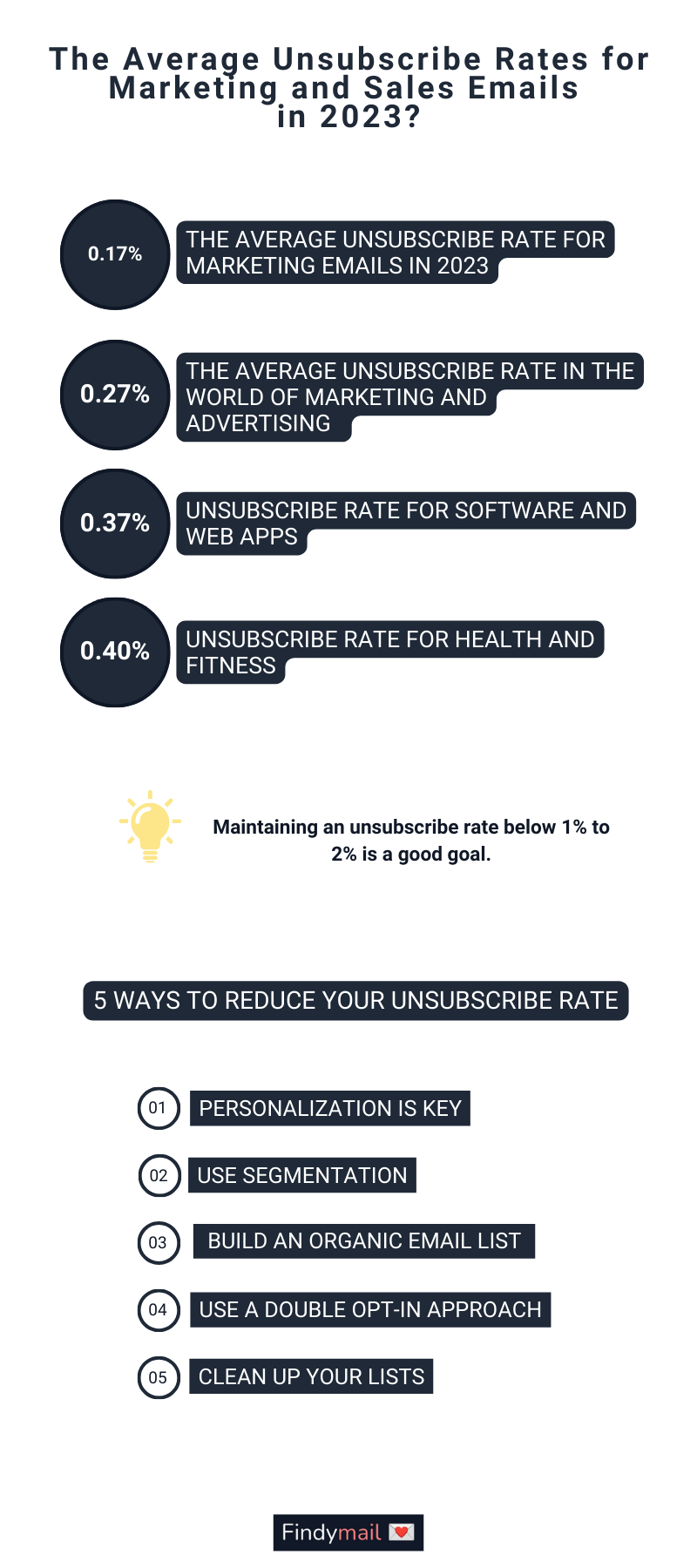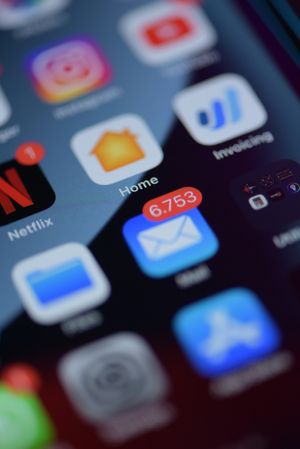Today, I want to dive into a topic that often gets overshadowed by the glitz and glamor of open rates, response rates, and conversions. Yes, you guessed it – I'm talking about the unsung hero of email metrics: the unsubscribe rate.
In this article, I want to shed some light on what the unsubscribe rate is, uncover a few common culprits behind those high numbers, and share some actionable tips to get you back on track.
Understanding Unsubscribe Rates: They Matter Too!
So, what exactly is the unsubscribe rate? Well, it's the percentage of subscribers who decide to bid us farewell by clicking that dreaded "unsubscribe" button.

Now, let's talk numbers.
- Research conducted by Neuailes Global found that the average unsubscribe rate for marketing emails in 2023 is around 0.17%.
- On the other hand, Campaign Monitoring discovered that the average rate sits at a slightly lower 0.1%.
Then, if we look at MailChimp, a popular email marketing platform, we see some interesting insights across various industries.
According to MailChimp's data, the average unsubscribe rate across all industries is around 0.27%.
They break it down for each industry. Here are some of the highlights:
- In the world of marketing and advertising, the average unsubscribe rate stands at 0.27%.
- Software and web apps have a slightly higher average at 0.37%.
- And e-commerce matches the average and marketing at 0.27%.
- Then if we look at an industry like health and fitness, the unsubscribe rate goes up to 0.40%.
So, what can we learn from these numbers?
Well, first of all, it's important to note that these rates may vary based on factors like audience demographics, content quality, and industry norms. However, they do give us a glimpse into the landscape we're navigating.
Looking at the averages, it's clear that maintaining an unsubscribe rate below 1% to 2% is a good goal to strive for. It means that the majority of our subscribers are sticking around and finding value in what we have to offer.
Of course, there will always be some inevitable churn, but by monitoring and improving our unsubscribe rates, you can continue to refine our email campaigns and keep our audiences engaged.
What Causes Unsubscribes?
These are the main reasons why people click the “unsubscribe” button:
1) The Content is Irrelevant
Picture this: you open an email, only to find it filled with content that doesn't matter to you. Frustrating, right? Well, you're not alone.
According to a survey conducted by Mailjet, a whopping 53.8% of respondents said they unsubscribe from emails because the content isn't relevant to them. It's a clear message that we need to ensure our content and product/service align with the interests and needs of our subscribers.
Personalization and segmentation are key to delivering targeted and engaging content that keeps our audience hooked.
2) They Only Signed up for a Specific Reason
We've all been guilty of this at some point – signing up for something because it offered a free download, a trial period, or access to the product/service.
And hey, there's nothing wrong with that! But let's not get upset when those subscribers jump ship once they've gotten what they initially signed up for. (After all, they won’t be qualified leads.)
It's essential to manage our expectations and recognize that some subscribers may have limited intentions from the start.
3) Unsolicited Promo and Sales Emails
Imagine opening your inbox and being bombarded with promotional emails you never asked for. It's no surprise that 57.1% of people would either mark those emails as spam or quickly hit that unsubscribe button.
Consent is crucial! Ensure that you have clear consent from your subscribers to send them newsletters and promotional materials.
Make sure you’re using legitimate tactics like double opt-in processes to build trust and avoid being flagged as spam.
4) You're Overdoing It
There’s a fine line between staying connected and overwhelming our subscribers. If you're sending emails all the damn time, it's bound to turn people off.
I’m sure you’ve experienced it – the flood of messages that feel like an invasion rather than valuable content.
Take a step back and evaluate your email frequency. Find the sweet spot that keeps your subscribers engaged without overwhelming their inboxes.
It’s like I always say: quality over quantity.
5) They Don't Recognize You
I know I’m not the only one who’s done this.
I sign up for something after a few beers or in the middle of the night, and then I completely forget about it the next morning.
It happens! According to that Mailjet survey, 54.9% of people said they unsubscribe from emails if they don't recognize the sender. It's a natural human tendency.
To combat this, make sure your emails identify your brand and provide a brief reminder of why the subscriber is receiving the email. Reinforce that connection and jog their memory.
5 Ways to Reduce Your Unsubscribe Rate
Here are a few simple but effective strategies to keep those unsubscribe rates at bay:
- Personalization Is Key: Show your subscribers that you know and care about them by delivering personalized content that speaks directly to their interests and needs. It's like having a friendly chat rather than a generic broadcast.
- Use Segmentation: Divide your email list into smaller segments based on factors like demographics, interests, or purchase history. By tailoring your messages to each segment, you'll increase relevance and engagement, keeping those unsubscribes at a safe distance.
- Don't Buy Email Lists: Building an organic email list might take a bit more time and effort, but trust me, it's worth it. Buying email lists often leads to low engagement and high unsubscribe rates. Focus on quality over quantity.
- Use a Double Opt-in Approach: Implement a double opt-in process where subscribers confirm their subscription via email. This ensures that they genuinely want to receive your emails, reducing the chances of hasty unsubscribes.
- Clean up Your Lists: Regularly review and clean up your email lists by removing inactive or unengaged subscribers. It's better to have a smaller, highly engaged list than a large one filled with disinterested recipients.
Don't Let Unsubscribes Take Over!
By understanding the unsubscribe rates, identifying common causes, and implementing effective strategies, you're well on your way to keeping those numbers in check and maintaining a strong connection with your subscribers (or leads).
But hey, here's a little secret sauce to keep those unsubscribe rates from exploding: Findymail. Always be confident you’re sending your emails to the right people with legit, verified email addresses.
Now get out there and get those subscriber numbers up!




